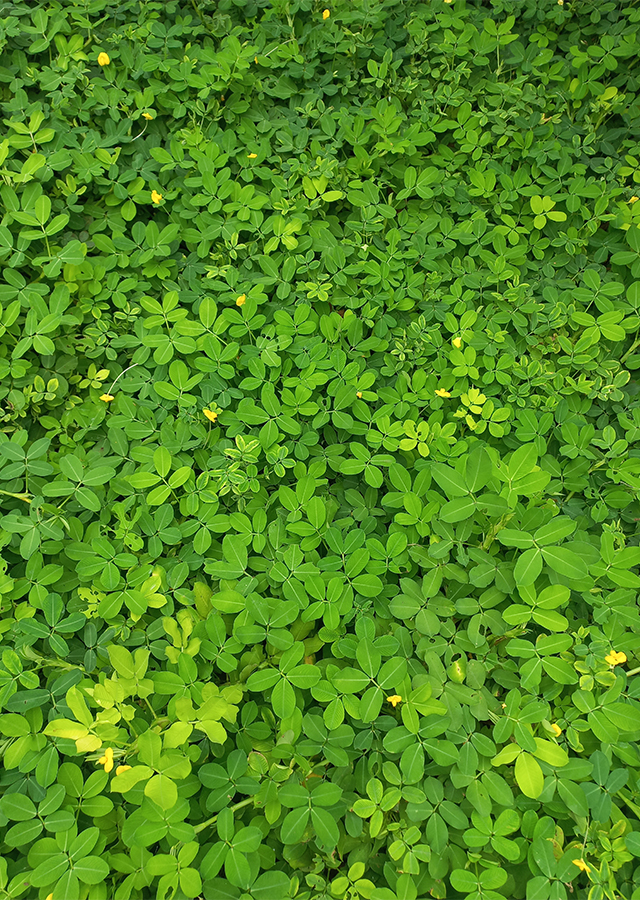Yellow Peanut Plant
Arachis pintoi Krapov. & W.C.Greg.
Fabaceae
Location in our garden
Principal



Synonym
-
Habitus
Herbaceous. Herbaceous perennial creeper plant, growing 0.2-0.5 m high.
Part Used
Leaves
Growing Requirements
Full Sunshine
Need Shade
Habitat
Forest
Roadside
Grassland
Terrestrial
Overview
Arachis pintoi is native to Central & East Brazil, then spread to Argentina, Australia, and the U.S., later on to the Pacific, South-East Asia and Central America. Named after the Brazilian botanist Geraldo Pinto, who first collected the plant from the locality of Boca do Corrego, municipio de Belmonte in 1954. The species was first described by A. Krapovickas and W. Gregory in 1994. It is an annual and grows primarily in the seasonally dry tropical biome. It is used as animal food and has environmental uses. The plant is increasingly being cultivated as a ground cover in tree plantations and as a component in pastures, where it is tolerant of heavy grazing.
Vernacular Names
Arachide de pinto (French), Amendoim-forrageiro (Portuguese), Maní forrajero (Spanish), Thua lisong tao (Thai), Mani-manian (Tagalog-Philippines), Co dau (Vietnamese).
Agroecology
A plant of the moist tropics, also succeeding in humid subtropical areas. It is found at elevations up to 1,400 m. It grows best in areas where annual daytime temperatures are within the range 22-28 °C, but can tolerate 12-30 °C. Top growth is killed by frost, but plants can regrow from the taproot if the frost was only light. It prefers a mean annual rainfall in the range 1,500-2,000 mm, but tolerates 900-3,000mm, and can tolerate a dry period of up to 4 months. The plant grows best in light shade, but is also tolerant of full sun and heavy shade. It grows well in most soil types, preferring a fertile soil but succeeding in soils of low fertility. It cannot reproduce in heavy clay soils, or in any soils that form a hard cap after rain, because the developing seedpod is unable to penetrate the soil and dies. It can tolerate low levels of salt in the soil. It prefers a well-drained soil, but can tolerate some water logging. Prefers a pH in the range 5.4-6, tolerating 4.5-7.5.
Morphology
- Roots - young plants have a stoloniferous root system, developing a strong taproot on older crowns.
- Stem - grow along the ground and root at the nodes.
- Leaves - pinnately-compound, each with 4 small oval leaflets that are pubescent on the lower surface. Leaves are shed during extended dry periods.
- Flowers - bright yellow, pea-shaped, produced on short axillary racemes. Flower stalks elongate and grow down into the soil.
- Fruit - a terminal one-seeded underground pod, light brown, 1-1.5 cm long, 6-8 mm in diameter.
Cultivation
- Generative propagation is by seed - when fresh it has a high level of dormancy, which may be reduced by drying the seed at 35-40 °C for 10 days. When growing the plant in new areas, the seed should be inoculated with a specific strain of Bradyrhizobium, which is different from that used on commercial groundnuts. Sow the seed in situ - a well-prepared seed-bed is desirable but not essential. The seed should be sown 2-6 cm deep.
- Vegetative propagation is by cuttings.
Chemical Constituents
Tannins, Essential oil, Lignin.
Traditional Medicinal Uses
- Studies have suggested antioxidant, anthelmintic, phytoremediative properties.
- In the Bikol (Philippines), leaves crushed and rubbed over insect and centipede bites.
Part Used
Reference Sources
- Fern, Ken.(2022). Useful Tropical Plants Database: Arachis pintoi. https://tropical.theferns.info/viewtropical.php?id=Arachis+pintoi. 26-02-2024.
- Flora Fauna Web. (2022). Arachis pintoi. https://www.nparks.gov.sg/florafaunaweb/flora/1/6/1684. 26-02-2024.
- Royal Botanic Gardens, Kew. (2023). Plants of the World Online: Arachis pitoi. Krapov, & W. C.Greg. https://powo.science.kew.org/taxon/urn:lsid:ipni.org:names:318518-2. 26-02-2024.
- Stuartxchange. (2018). Pilippine Medicinal Plants: Mani-manian. Arachis pintoi Krapov & Greg. GOLDEN GLORY. http://www.stuartxchange.org/Mani-manian.html. 26-02-2024.

